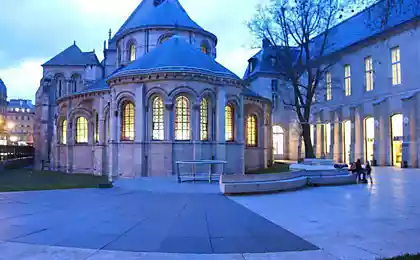1125
The museum "Submarine B-440"
Writes russos
Really what we did not expect to see in Vytegra, located on the border of the Vologda region and the Karelian Republic, it's diesel-electric submarines Project 641 "B-413", which is now converted into a museum. Honestly, there is no clear explanation why they decided to make this unusual museum, except to mention that Vytegra gave Homeland 5 admirals, I have not found. Nevertheless, in the long journey to the north you can make a short stop there and see this wonderful museum.
Submarines of Project 641 - a series of Soviet diesel-electric submarines (Foxtrot by NATO classification). The project was considered successful. It was built 75 ships, including 17 for export to the naval forces of various countries. The project was a logical development of 611 projects, which in turn was based on the German elektrolodkah XXI series. Here's a continuity.
39 photos of memorable museum

But back to our "B-440»:
February 11, 1970 was credited with a list of Navy ships.
September 16, 1970 launched as a large torpedo submarine.
January 16, 1971 after the test was a part of the Red Banner Northern Fleet.
In 1988, the Group entered into search submarines NATO naval
In 1994, listed in the DKBF.
In 1996, listed in the LenVMB.
In 1998, excluded from the Navy and transferred for disposal.
In 2003, the museum began renovations to the Vologda region of Kronstadt sea plant.
2005 - completed renovations to the museum. Most of the compartments maintained in full, the rest is used for the operation of the museum. In Vytegorsky Bay produced dredging - a necessary condition for receiving a submarine museum, which is made fast to the shore line. In Vytegra submarine was taken in the waters of lakes Ladoga and Onega.
December 10, 2005 submarine became the basis for the Museum of military glory sailors.
2. Under the project 641, developed under the leadership of SA Egorova, and then ZA Deribina, a streamlined body is made with a little sheer, sharp, beveled stem to improve navigability on the surface. Placed in front fairings sonar hydrophones and down bow made a cubicle for this equipment. 1st torpedo compartment was with 6 devices from which you can shoot from a depth of 80 m. 2nd - residential (There is also a mess-room), there were under the floor of a high-capacity batteries. in the 3rd traditionally housed the central office. in the 4th, as in the 2nd, was housing (also located galley) and batteries. In the 5th were diesels in the 6th - propulsion motors, 7th, Stern, was also a torpedo. Fencing cutting designed quite high, above it were periscopes and antennas, in the fairing are mine machine for diesel engines under the water and flue gas.

3. Now it is a museum. In it, in addition to the boats, there are additional exposure:
- Exhibition of ship lanterns "Navigation lights»
- Exhibition on the history of marine costume
- Exposition dedicated to the sailors of the nuclear submarine "Kursk»
- The exhibition "Location Service Ocean" about sailors who served on a submarine B-440

4. Exhibition of ship lanterns "Navigation lights".
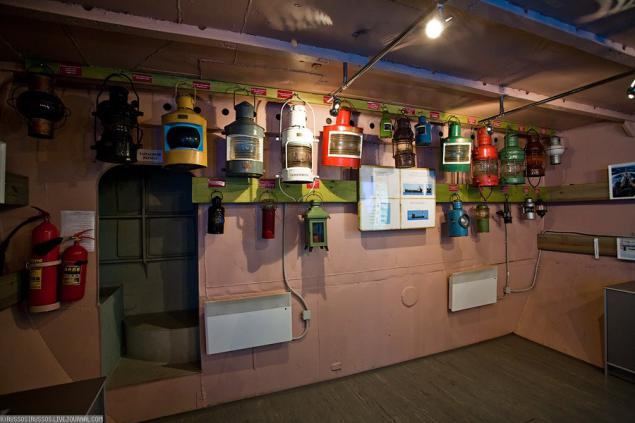
5. Mast. The exhibition is located in the former lanterns battery pit, in which among other things made a small conference room and stand with reference to the other submarines museum and memorial tower.

6. Post a radio operator.

7. In the boat removed, unlike the "B-413" in Kaliningrad, part of the partition between the compartments. In the photograph the view from the second compartment in the third - central.

8. Some pokazomery. Generally I nasnimal many devices. Of the ones I know, I will write more.

9. Or use the finished plate. This, for example, gyro repeater.

10. Remote control ship's communications.

11. Latrine.

12. In this boat, you can climb the bridge. Actually left the door in a durable housing, the right is another gyro repeater and uh ... it seems such a steering wheel.

13. It is possible to climb even higher and look at the street.

14. In the boat were always some visitors. Although the impression of them was very negative. 90% - some drunken rednecks, which has secured for fun.

15. Luke in a durable housing.

16. The device №12-54

17. Remote control torpedo firing. Do not quite understand what exactly it manages.
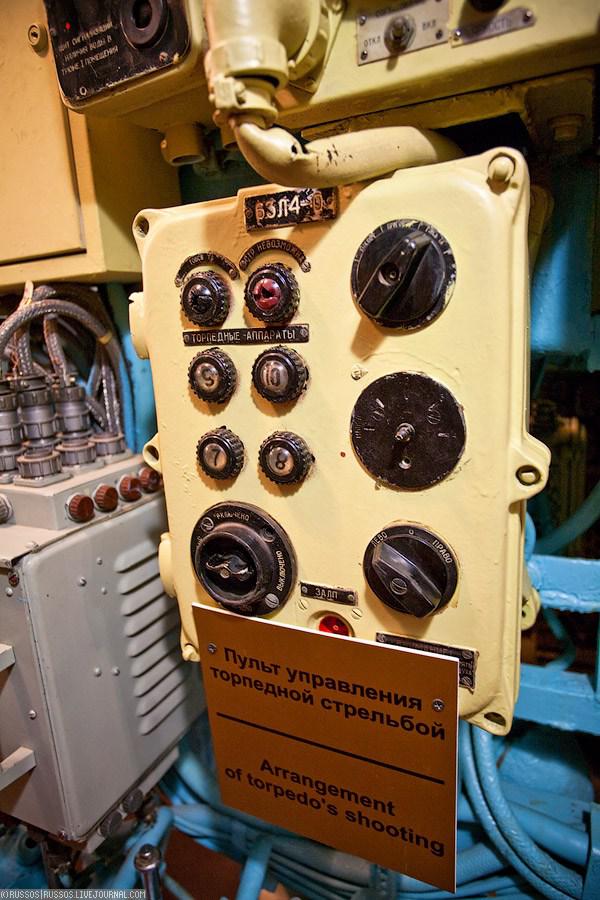
18. Telephone dream.
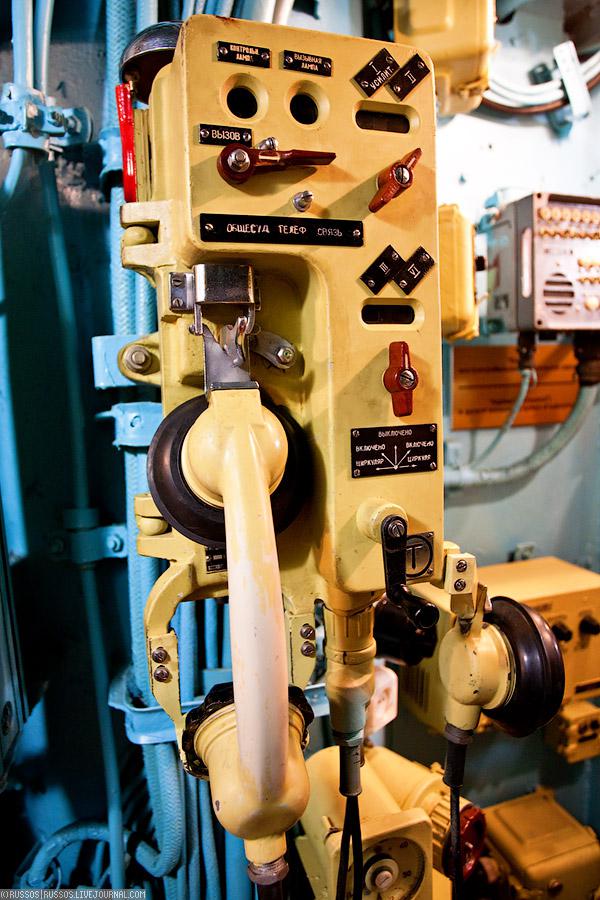
19. Central post. Left - the dive station. In the distance, the yellow barrel, similar to erdva-deadweight - gyrocompass.

20.Pult hold or Christmas Tree - Illuminated display showing the status of the various valves. When burning all zelyne, then all you need - Zadran. And you can dive.

21. The device 6.

22. Remote control torpedo firing. A sort of analog-mechanical computer.

23. Oh, what plugs!
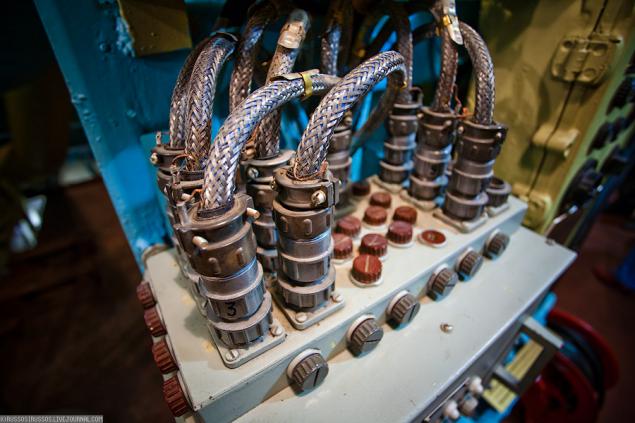
24. navigational device.

25. Shows passed course, makes automatic plotting.

26. One of the bulkhead with zadraennym hatch.

27. Diesel t.2D-42M. Never ceases to amaze its size. Compared with the monsters on the D-2 is just a little girl. Central Diesel apparently removed (there were three). You can see an opening in the floor covered by it.

28. The valve exhaust.
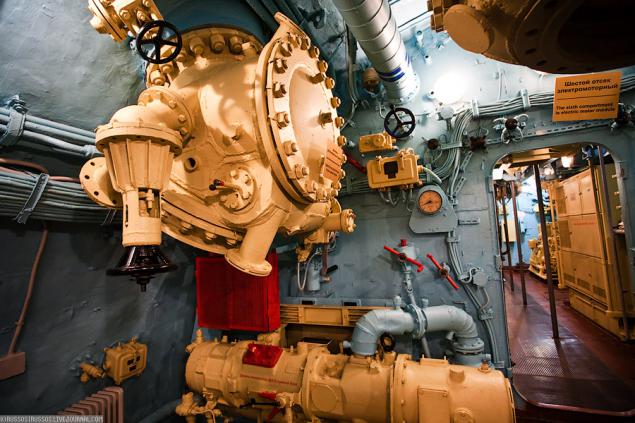
29. Shield automatic converter.
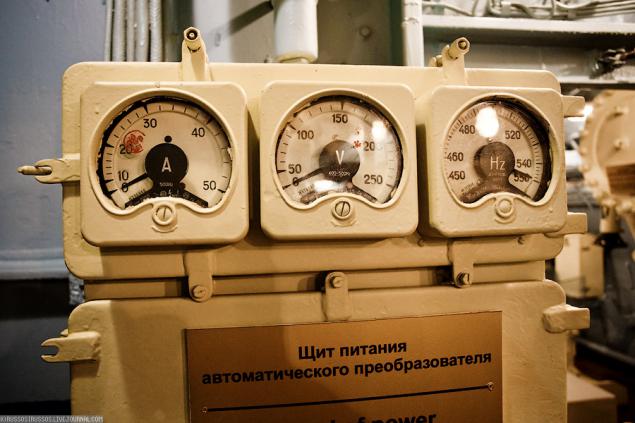
30. Compressor.

31. The 6th slot motors. Um, on a mannequin nominal form?

32. Suddenly, in the seventh compartment found an old diving kostyus with fanfare.

33. Feed torpedo tubes.

34. Berths sailors.

35. Some clutch rowing valah.Na photograph shows two shafts, although their dolzhnobyt three. It seems the third to the left of me, even though there are already closely Yes, it is under the floor of the 6th compartment.
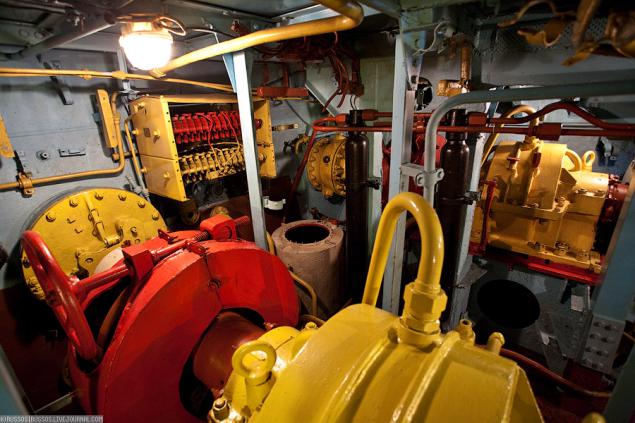
36. Diesel engines. Centered whether the remains of the third valve from the disassembled output, or escape hatch.

37. The first compartment. 6 torpedo tubes

38. The boat on the shore of the Onega Flotilla. In Vytegra, during the war, settled its headquarters.

39. One last look at the beautiful submarine in Moscow.

Source:
Really what we did not expect to see in Vytegra, located on the border of the Vologda region and the Karelian Republic, it's diesel-electric submarines Project 641 "B-413", which is now converted into a museum. Honestly, there is no clear explanation why they decided to make this unusual museum, except to mention that Vytegra gave Homeland 5 admirals, I have not found. Nevertheless, in the long journey to the north you can make a short stop there and see this wonderful museum.
Submarines of Project 641 - a series of Soviet diesel-electric submarines (Foxtrot by NATO classification). The project was considered successful. It was built 75 ships, including 17 for export to the naval forces of various countries. The project was a logical development of 611 projects, which in turn was based on the German elektrolodkah XXI series. Here's a continuity.
39 photos of memorable museum

But back to our "B-440»:
February 11, 1970 was credited with a list of Navy ships.
September 16, 1970 launched as a large torpedo submarine.
January 16, 1971 after the test was a part of the Red Banner Northern Fleet.
In 1988, the Group entered into search submarines NATO naval
In 1994, listed in the DKBF.
In 1996, listed in the LenVMB.
In 1998, excluded from the Navy and transferred for disposal.
In 2003, the museum began renovations to the Vologda region of Kronstadt sea plant.
2005 - completed renovations to the museum. Most of the compartments maintained in full, the rest is used for the operation of the museum. In Vytegorsky Bay produced dredging - a necessary condition for receiving a submarine museum, which is made fast to the shore line. In Vytegra submarine was taken in the waters of lakes Ladoga and Onega.
December 10, 2005 submarine became the basis for the Museum of military glory sailors.
2. Under the project 641, developed under the leadership of SA Egorova, and then ZA Deribina, a streamlined body is made with a little sheer, sharp, beveled stem to improve navigability on the surface. Placed in front fairings sonar hydrophones and down bow made a cubicle for this equipment. 1st torpedo compartment was with 6 devices from which you can shoot from a depth of 80 m. 2nd - residential (There is also a mess-room), there were under the floor of a high-capacity batteries. in the 3rd traditionally housed the central office. in the 4th, as in the 2nd, was housing (also located galley) and batteries. In the 5th were diesels in the 6th - propulsion motors, 7th, Stern, was also a torpedo. Fencing cutting designed quite high, above it were periscopes and antennas, in the fairing are mine machine for diesel engines under the water and flue gas.

3. Now it is a museum. In it, in addition to the boats, there are additional exposure:
- Exhibition of ship lanterns "Navigation lights»
- Exhibition on the history of marine costume
- Exposition dedicated to the sailors of the nuclear submarine "Kursk»
- The exhibition "Location Service Ocean" about sailors who served on a submarine B-440

4. Exhibition of ship lanterns "Navigation lights".

5. Mast. The exhibition is located in the former lanterns battery pit, in which among other things made a small conference room and stand with reference to the other submarines museum and memorial tower.

6. Post a radio operator.

7. In the boat removed, unlike the "B-413" in Kaliningrad, part of the partition between the compartments. In the photograph the view from the second compartment in the third - central.

8. Some pokazomery. Generally I nasnimal many devices. Of the ones I know, I will write more.

9. Or use the finished plate. This, for example, gyro repeater.

10. Remote control ship's communications.

11. Latrine.

12. In this boat, you can climb the bridge. Actually left the door in a durable housing, the right is another gyro repeater and uh ... it seems such a steering wheel.

13. It is possible to climb even higher and look at the street.

14. In the boat were always some visitors. Although the impression of them was very negative. 90% - some drunken rednecks, which has secured for fun.

15. Luke in a durable housing.

16. The device №12-54

17. Remote control torpedo firing. Do not quite understand what exactly it manages.

18. Telephone dream.

19. Central post. Left - the dive station. In the distance, the yellow barrel, similar to erdva-deadweight - gyrocompass.

20.Pult hold or Christmas Tree - Illuminated display showing the status of the various valves. When burning all zelyne, then all you need - Zadran. And you can dive.

21. The device 6.

22. Remote control torpedo firing. A sort of analog-mechanical computer.

23. Oh, what plugs!

24. navigational device.

25. Shows passed course, makes automatic plotting.

26. One of the bulkhead with zadraennym hatch.

27. Diesel t.2D-42M. Never ceases to amaze its size. Compared with the monsters on the D-2 is just a little girl. Central Diesel apparently removed (there were three). You can see an opening in the floor covered by it.

28. The valve exhaust.

29. Shield automatic converter.

30. Compressor.

31. The 6th slot motors. Um, on a mannequin nominal form?

32. Suddenly, in the seventh compartment found an old diving kostyus with fanfare.

33. Feed torpedo tubes.

34. Berths sailors.

35. Some clutch rowing valah.Na photograph shows two shafts, although their dolzhnobyt three. It seems the third to the left of me, even though there are already closely Yes, it is under the floor of the 6th compartment.

36. Diesel engines. Centered whether the remains of the third valve from the disassembled output, or escape hatch.

37. The first compartment. 6 torpedo tubes

38. The boat on the shore of the Onega Flotilla. In Vytegra, during the war, settled its headquarters.

39. One last look at the beautiful submarine in Moscow.

Source:




















